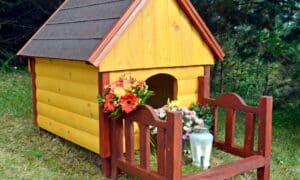“This post contains affiliate links, and I will be compensated if you make a purchase after clicking on my links.”
The Natural Life Cycle of a Dog is something that we as responsible owners should give a little thought to. Dogs are living beings like humans, and have a natural life cycle we need to be aware of. They are born from their parents, raised until the proper age, grow up to be mature adults, explore the world, and eventually pass away like us. They share experiences with their owners and fellow dogs – hence they are social animals and need to learn proper skills. When raising a dog, proper training for socialization, discipline, and many other factors are very important to prevent unwanted behavior when the dog grows up. Here are some basic stages of a dog’s complete life cycle, and some of the things a dog needs during those various stages:
Natural Life Cycle of a Dog
Embryonic Stage
- 0-19 days: This is the start of fertilization. An embryo is formed from the joining of 2 cells. As time passes, they multiply to 4 and eventually 64 or more.
- 20-33 days: The eyeballs, legs and paws start to take shape on the embryo.
- 40 days: The embryo is now a fetus and begins to have a noticeable heartbeat.
- 55 days: Their movement increases in this stage. A coat of hair, along with nails and paws appear, as well as milk teeth inside the gums.
- The most important thing we owners can do during this stage is to make sure the expectant mother gets proper nourishment, and has her comfort needs met.
Puppy Stage
- 0-2 weeks: All puppies are born blind and deaf until they reach a certain age (around 10-14 days). They heavily depend on their mother in this period. Senses such as smell, touch and taste begin to develop. And after 2 weeks, their ear canals will open up. Also take note that learning social interaction begins at this stage. Holding them and gently talking to and petting them will get them off to a good start with humans.
- 2-4 weeks: The puppy’s eyes will open, allowing him to see the beautiful world. The first teeth will come out, and he will be able to regulate his own body temperature. Basic locomotion such as crawling, standing and walking are learned in this period.
- 4-12 weeks: Sense will start to mature here and social interaction is increased. This is very important, so let your puppy play around and enjoy life. Also, his fear response begins to develop so one should expose him to various things around the house, and start taking him outdoors.
- 3-6 months: This is a good stage to develop a dog’s behavior by starting obedience training, because he starts to build up energy and he needs to learn that it must be properly channeled. Also, he develops his social sense and becomes independent. Teething occurs and sexual maturation begins. Permanent growth of the teeth is also completed in this stage (around the 5th month).
- 6-18 months: The dog continues to grow along with his social learning. He will also have high energy levels at this point, and will have also reached his sexual maturity.
Adolescence
- Just like us humans, this is probably the most trying, challenging stage of development for the “parents”, aka “owners”! The following excerpt from an eHow.com article says it best:
At the moment when owners start to relax because their puppy is well house trained and no longer chewing everything in sight, the puppy reaches the most challenging part of the dog’s life: the teenager stages. This stage begins between six and eighteen months and ends between one and three years. Adolescent dogs will challenge their owners, test their limits and act as if they have never heard a command. Physically they are reaching sexual maturity if not spayed or neutered, they will become interested in the other sex.
(For some reason, that sounds just like me as a teenager!)
Adult Dog Stage
- The adult age of a fully matured dog occurs when he is around 2 years old. His senior years start when he is around 7 years old.
- During these stages, the dog has become fully matured, independent and responsible.
- Remember that everything that happened to him as a pup will carry on for the rest of his life.
- For dogs to stay fit, regular exercise and and a healthy diet is needed.
Rainbow Bridge
- The average life span of a dog depends on the species, but it is usually around 11-12 years. However, there are some dogs that even make it past 20.
- When a dog ages, their facial hairs turn to gray and it may also suffer from many of the same maladies as elderly humans, such as joint pains, hearing loss, cataracts, and kidney disorders.
- Sticking to natural foods as much as possible, and making sure your dog has regular healthy habits will not only possibly prolong the life of your dog, but also make its final years happy, comfortable, and hopefully pain free.
All of us basically know the The Natural Life Cycle of a Dog, and by being more attentive to what the dog needs during the various stages we can be of great assistance in our pet’s life journey.
Do you enjoy watching your dog as it progresses through life’s stages? They can be a real joy and comfort as we pass through our own. Feel free to share your thoughts below.






















Could you tell me how many years a Border Collie will live for also how many years would an Australian Terrier live for. Kind Regards Glenn
This is a good post because I have to do a poster
THANKS
Mikkybee1
says:How long does it take a Dog to recognise or being used to a strenger in a compound?
Mikkybee1
says:Beautiful but i don’t have a Dog
but someone told me that a six months old dog is equivilent to a year old human, is that true?
The domestic dog is a subspecies of the gray wolf, a member of the Canidae family of the mammalian order Carnivora. The term “domestic dog” is generally used for both domesticated and feral varieties.
saree25
says:wow nice for a informational book
Trisha
says:l
Alexia Thompson
says:I’m doing a report on the life cycle of a dog and this website is amazing! I will gladly come on this website a lot.
Ian
says:Wow.Lol
alyssa
says:wow that was so cute
My dog (a little gold Corgi) is now about 6 years old. In the last year, I’ve noticed her snout becoming gray and i can tell she is getting older. She (Rory) was sleeping a lot and found that taking her for a daily walk has greatly improved her energy but also helps her sleep deeper. The walk helps her in so many ways, I know she loves it. Since she is getting older, I think it is very important to exercise her regularly which like in humans, can impact her lifespan and more likely stave off canine age-related dementia that can occur in an aged dog.